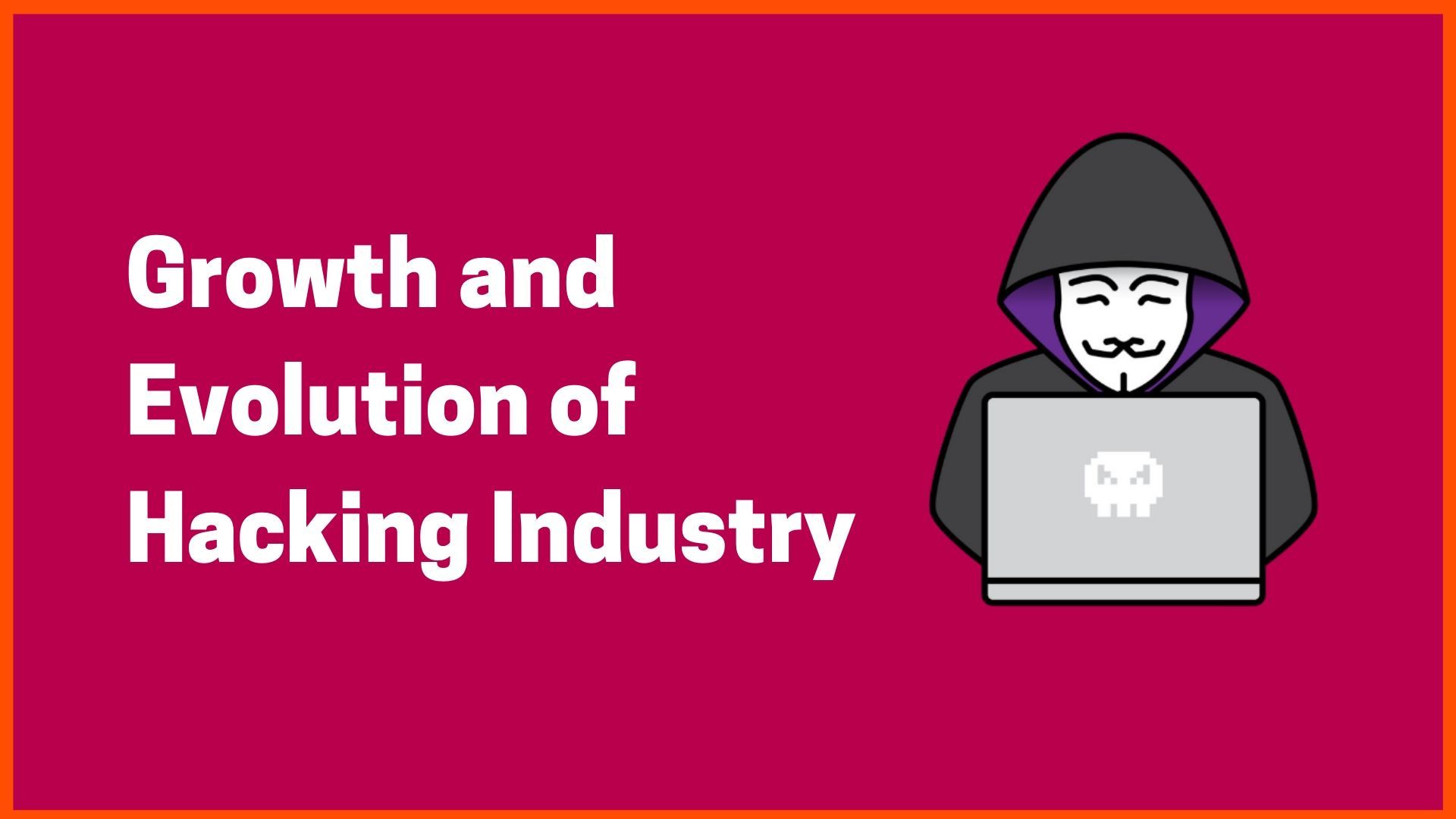Growth and Evolution of Hacking Industry
🔍Insights
They’re smart. They know their code. They got the ardor to get into your system. The strengths and the backdoors, they know it all. Yes, we’re talking about the brilliant minded, cyber thrill seekers called Hackers. The term hacking, means to gain unauthorised access in someone’s computer or private network for some illicit purpose.
Nowadays, the word “hacker” carries an excessively negative connotation, projecting images of digital thieves intent on stealing identities and letting disruptive viruses loose into cyberspace.
It wasn’t always the same. In fact, computer hackers were originally viewed by society as technology fanatics who wanted nothing more than to optimize, customize and improvise. Decades later, with the growth of viruses and cyber crime – the traditional hackers got stuck together with those of malicious purpose and the censure of hacking began.
Curious as to how this evolution came to be? Let us now see the complete story behind the topic- Growth and Evolution of Hacking Industry.
History of Hacking Industry
Current Trends in Hacking Industry
History of Hacking Industry
Hacking originated from the term “phreaking” (hacking phone systems), in the late 1990s and early 2000s. Gaining access within networks was called “cracking.” The primary motive of hackers was to get into the phone system.
1980s brought with it the personal computers. More people, businesses and governments adopted to them, and a whole new world of technology fascinated the hackers. They had a gala time playing around in this new tech realm, and simultaneously, discovering the loop holes in the network.
The law responded swiftly. The emergence of cyber criminals was met in 1986 with the first legislation related to hacking, the Federal Computer Fraud and Abuse Act but this didn’t stop these criminals.
Initially, hacking was primarily done to get the adrenaline rush—the computer equivalent of sky diving.But over time, these players realized that they could make money off of their skill. Why destroy a file, corrupt a program and play cat-and-mouse with the IT team when you can rip them off with a code? A black market began to surface.
By 2003, Microsoft was offering money to hackers that could corrupt Windows. Ethical hacking took birth to discover vulnerabilities and fix them before an unethical hacker gets in.
Also Read: How Anshul Saxena became a Cyber Hero after the Pulwama Attack
Current Trends in Hacking Industry

When cybercrime takes place on a larger scale, like to a giant retailer, the damages value upto tens of millions for a single business.
Hackers make use of hardware and software to test how easily a computer network can be infiltrated. Vulnerabilities are sited at any one of a number of points, such as the Internet connection itself, the browser or the operating system of the user’s computer.
A decade ago, hackers crashed computers, making the user instantly aware they were hacked. Nowadays, hackers leave no proof. How could they get your banking information if your computer is crashed?
Instead, they inject a Trojan that waits, undetected, then springs into action when you begin online banking—transferring information to the hacker.
By the mid 2000s hacking was carried by state sponsored hackers, organized criminals, hacktivists and cyber terrorists. Some political attacks like the interference by the Russians in the 2016 Presidential Election or the Stuxnet virus.
Hacktivists groups use their fervour about certain beliefs and plot an attack against a group that they disagree with. For example, a hacktivist group known as “Anonymous” attacked the Church of Scientology by flooding its servers with fake data requests. All they wanted was for the Scientology website to take down a video of Tom Cruise endorsing from their website.
Most attackers hack for the money. They hack into system and demand large ransom payments to prevent information leak.
There were 1,903 breaches disclosed and 1.9 billion exposed records in Q1 alone, according to RiskBased Security.
Some repeated patterns that were traced are:
1) Presence of Misconfigurations
43% of data breaches linked misconfigurations analyzed by X-Force. That accounts for 990 million records lost.
2) Phishing is still there
29% of cybersecurity attacks used phishing, according to go X-For ce. About half of the latest phishing attacks involve hackers fiddling with business email.
3) Coin-mining malware
Cryptojacking(unauthorised use of someone else’s computer to mine cryptocurrency) attacks grew a surprising 450% last year, according to Proofpoint.
4) Extortion as the new ransomware
Includes credential theft, downloaders, and infected attachments. There has also been a significant surge in direct attempts to blackmail executives.
5) Missing passwords
Nearly three-quarters of the records lost in 2019 contained email addresses and passwords, per RiskBased Security. 10% had credit card or social security numbers.
6) Malicious domains
About 10 million DNS requests to harmful sites are blocked each day, according to X-Force.
7) SMS leads to malware
Android malware named TimpDoor raised prominence in early 2019. When an attack starts, users are generally prompted to download a malicious app via SMS phishing, or “smishing,” according to McAfee. These apps install an unforeseen backdoor that gives hackers access to corporate and home networks.
Current Market Size and Future Projection of Hacking Industry
Hacking collectively called Cybercrime is a major threat to every organisation in the world, its effect on society is reflected in the Official 2019 Annual Cybercrime Report, announced by Cybersecurity Ventures.
As per the report, it will cost the world $6 trillion annually by 2021, up from $3 trillion in 2015 marking the greatest transfer of economic wealth in history, risking the reason for innovation and investment.
Cybercrime might triple the number of jobs to 3.5 million unfilled cybersecurity positions by 2021 -- which is up from 1 million in 2014 - and the cybersecurity unemployment rate will remain at 0%.
The international cyber security market size was at USD 131.3 Billion in 2018 is expected to reach USD 289.8 Billion by 2026, according to fortune business insights.
Global security spending on identity access management is accounted to reach 10.58 billion U.S. dollars in 2019. Spending on security services, the largest segment of the information security market, might reach 64.24 billion U.S. dollars in the same year as per Statistica report.
Also Read: IT Services giant Cognizant Hit by ‘Maze’ Ransomware
Conclusion
Hacking trends are tricky to predict.With that said, there are a few ways you can innovate faster than hackers and respond to emerging threats in 2019 and beyond.
*) Protect the endpoints
Hardware weaknesses are common, means hackers can keep harvesting data in the easily. It should be kept in mind that the time to address device vulnerabilities is before data loss.
*) Analyse human error
Hackers sense vulnerability, and they target the weakest link in your network. Sophisticated social engineering as well as less-sophisticated blackmail attempts take place. Some user may click on spammy attachments, even after years of training.
Awareness should be spread. Invest in smarter spam filters and devices that can quarantine and eliminate threats before they infect your network.
*) Visibility is a security advantage
Hackers love it when you make their job easy with an unprotected cloud database or printers protected with easy passwords. The solution is to install services that enable you to understand risks across multiple cloud environments and multi-vendor printers.
Must have tools for startups - Recommended by StartupTalky
- Convert Visitors into Leads- SeizeLead
- Website Builder SquareSpace
- Manage your business Smoothly Google Business Suite





